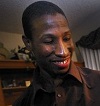 Photo of DeAndre Howard by Bob Chamberlin, Los Angeles Times About 8:00 p.m. on July 8, 2002, 42-year-old Mark Freeman and 31-year-old Arthur Ragland were standing outside a liquor store near the corner of 42nd Street and Hoover in Los Angeles, California, when a black man got out of the front passenger side of a car and shot them both several times. Freeman was killed and Ragland was seriously wounded.
The man then got back into the car, a white Nissan containing two other black men, and the car sped off. Police did not find any weapons, but did recover 10 shell casings—five each of two different calibers.
Ragland did not identify the shooter and police thought that because Ragland was in a street gang, he was refusing to cooperate in what appeared to be a gang-related shooting.
In October 2002, Sergio Hernandez, who was working in the liquor store at the time of the shooting, identified 20-year-old DeAndre Howard as the gunman after viewing Howard’s picture in a photographic lineup. Dina Fontaine, Freeman’s former girlfriend, who also saw the shooting, initially picked Howard in a photographic lineup, but later said she was no longer sure she knew what the gunman looked like.
Howard was arrested and charged with first-degree murder and attempted murder with a handgun.
Howard went on trial in Los Angeles County Superior Court in September 2003. Hernandez identified Howard as the gunman. Hernandez said he recognized him again prior to the trial after Hernandez was arrested on an unrelated matter and saw Howard in a holding cell. Fontaine was called as a witness, but while she said she could not identify the shooter, she also said the gunman was not Howard.
Howard, who had prior convictions for drug possession and forgery, was the only defense witness and he denied being the shooter. He said he could not remember exactly where he was at the time of the crime, but that probably he was either at home, at work, with his girlfriend or with his parole officer.
On September 8, 2003, a jury convicted Howard of first-degree murder and attempted murder. He was sentenced to life in prison.
In September 2004, Ragland gave a sworn statement to Howard saying that had he been called as a witness at Howard’s trial, he would have testified that Howard was not the gunman. Ragland, who was a street gang member and had an extensive criminal record, said in the statement that he refused to meet with detectives at the time because he had an outstanding warrant and did not want to be taken into custody. “I was evasive and non-cooperative, the truth (is that) DeAndre Howard never attempted to murder me, neither did he murder victim Mark Anthony Freeman,” the statement said.
Howard lost his direct appeal and several attempts to vacate his conviction by state petitions for writs of habeas corpus. In 2007, he filed a federal petition for a writ of habeas corpus claiming that his trial lawyer had provided constitutionally ineffective assistance by failing to interview Ragland and call him as a witness at trial. The habeas petition was denied in 2010 by a U.S. District Court Judge, but in 2011, the Ninth Circuit U.S. Court of Appeals remanded the case back to the District Court and ordered a hearing on the claim of an inadequate legal defense.
The hearing was held in May 2011 and Ragland testified that Howard was not the gunman and that he would have said so at Howard’s trial if he had been called as a witness. The investigator who was appointed to assist Howard’s defense lawyer testified that the lawyer was “very indifferent, very distant” and was in a hurry to finish Howard’s case because the lawyer had two death penalty cases pending. The lawyer, Joseph Orr, was deceased by the time the hearing was held.
In October 2011, Howard’s habeas petition was granted by the District Court, his conviction was vacated and a new trial was ordered.
The prosecution appealed and in August 2012, the Ninth Circuit Court of Appeals upheld the decision.
In December 2013, after rejecting a prosecution offer to plead guilty to involuntary manslaughter in return for his immediate release, Howard went on trial for a second time.
Hernandez again identified Howard as the gunman and testified that he was 20 to 30 feet away from the gunman. The defense presented evidence for the first time that showed he was actually about 90 feet away; that he was behind an iron fence that partially obstructed his view; and that the shooter was facing away from Hernandez for all but a few seconds.
Because Hernandez is Hispanic and Howard is black, the defense also called an expert witness who testified about the unreliability of cross-racial eyewitness identifications.
Ragland testified for Howard and said that Howard was not the gunman.
On December 20, 2013, a jury acquitted Howard and he was released.
In 2015, Howard filed a motion for a certificate of innocence, but it was denied. He then filed a claim for compensation from the state of California.
In March 2018, a hearing officer at the California Victim Compensation board recommended Howard be granted $417,200 in compensation. However, the compensation board rejected that recommendation, concluding by a vote of 2 to 1 that Howard had failed to prove his innocence. As a result, compensation was denied.
– Maurice Possley
|